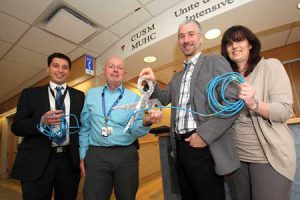
By Neale McDevitt
It’s like being the kid at the candy store window who has no money to buy sweets. For years, McGill students and researchers working at McGill University Health Centre (MUHC) facilities had been unable to gain access to McGill servers because the Ministry of Health regulations concerning the interconnection of networks are extremely restrictive and complex.
“The MUHC has their own WiFi system and they will support MUHC machines,” said Spiro Mitsialis, Manager, Network Infrastructure, Network and Communications Services (NCS) “This meant a lot of McGill researchers with McGill machines who were now working within the hospitals were having a hard time getting work done. It wasn’t very efficient, to say the least.”
Last fall, when the MUHC IT team approached McGill NCS to collaborate on a project that would rectify the situation, Mitsialis jumped at the opportunity.
“They told us that they had come up with a way to give people access to McGill servers through the MUHC’s wireless network,” he said. “We collaborated on a successful pilot in the fall and on March 1 we launched it.”
Claude Lessard, Associate Director, MUHC Information Services, and his team were faced with a number of challenges. To reduce duplication, they use a proxy authentication process. “When you want to access McGill networks you don’t have to register twice, once on the MUHC site, and then get redirected to McGill where you have to re-register,” he said. “When you connect to MUHC you are asked for your password and login name, but you are automatically authenticated at McGill. Otherwise we would have had to maintain two sets of access databases.”
But having additional users doesn’t mean slower network services for MUHC employees. McGill traffic flows on a special channel that already exits between the University and the MUHC, which means the latter’s bandwidth isn’t overtaxed.
While not all MUHC facilities have WiFi, the network is expanding – which, by extension, means McGill’s network is growing as well. As existing buildings are refurbished or renovated and new buildings are built, they get equipped with WiFi capability – provided they aren’t slated to close upon the completion of the Glen Campus, which is expected in 2014.
That being said, some of the older MUHC complexes have been fitted with WiFi because of special circumstances. The Royal Victoria Hospital, for example, has WifI capability in its emergency area because it is equipped with carts that use wireless technology to gather patients’ vital signs. “If I’m waiting in the emergency room there I can actually get some work done,” said Mitsialis.
So far the new system has been a success, so much so that Mitsialis and his colleagues have been contacted by other Canadian institutions facing similar challenges. For his part, Lessard knows things are going well because of the silence. “So far, the project has gone beyond our expectations,” he said. “It has been several months since deployment and we’ve had virtually no complaints.”
With industry numbers showing that the average individual has 2-3 electronic devices, this kind of network access for McGill students and researchers is invaluable.
“It doesn’t matter if you do work at the MUHC or not, if a student is sitting in the corner of a coffee shop in one of our buildings and he is able to receive our signal, he can connect to McGill with any device,” said Lessard. “iPad, iPhone, iWhatever.”
